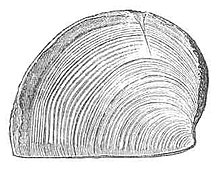

This article includes a list of general references, but it lacks sufficient corresponding inline citations. Please help to improve this article by introducing more precise citations. (November 2013) (Learn how and when to remove this message)
|


Anaptychus is a type of marine fossil. It is a hard anatomical structure, a sort of curved shelly plate, now understood to be part of the body of an ammonite. Paired aptychi have, on rare occasions, been found at or within the aperture of ammonite shells. The aptychus was usually composed of calcite, whereas the ammonite shell was aragonite.
Aptychi can be found well-preserved as fossils, but usually quite separate from ammonite shells. This circumstance led to them being initially classified as valvesofbivalves (clams), which they do somewhat resemble. Aptychi are found in rocks from the Devonian period through to those of the Cretaceous period.[1]
There are many forms of aptychus, varying in shape and in the sculpture of the inner and outer surfaces. However, because they are so rarely found in position within the ammonite shell, it is often unclear which kind of aptychus belonged to which species of ammonite.
When only a single plate is present, as is sometimes the case, the term "anaptychus" is used.
Aptychi seem to have most often existed as bilaterally-symmetrical pairs, and were first described (incorrectly) as being the valves of bivalve mollusks. Aptychi are now considered to be a two-valved closing hatch on the shells of extinct ammonites or a double-plate jaw-piece similar to that of some modern cephalopods.[2][3][4][5]
Set near to or against the shell's terminal opening (the living chamber), the aptychi usually consisted of two identical but mirror image valves. Some authors consider the aptychus to be a jaw apparatus (mandibles), while others believe them to be paired opercula. If the latter is the case, then aptychi may have had a function similar to the head shield of modern nautiluses.
{{cite journal}}: CS1 maint: multiple names: authors list (link)
|
Cephalopod anatomy
| ||||||||||||||
|---|---|---|---|---|---|---|---|---|---|---|---|---|---|---|
| Shell |
| |||||||||||||
| Mantle & funnel |
| |||||||||||||
| Head & limbs |
| |||||||||||||
| General |
| |||||||||||||
Developmental stages: Spawn → Paralarva (Doratopsis stage) → Juvenile → Subadult → Adult • Egg fossils • Protoconch (embryonic shell) | ||||||||||||||